Some of the links in this post may be affiliate links.
Philodendron Brasil is one of the many beautiful and easy to grow Philodendron varieties out there. The variegated foliage is delightful! Keep reading to learn how you can grow this plant beautifully. Also learn how to keep your Philodendron bushy, and make more plants to keep for yourself or give to friends!
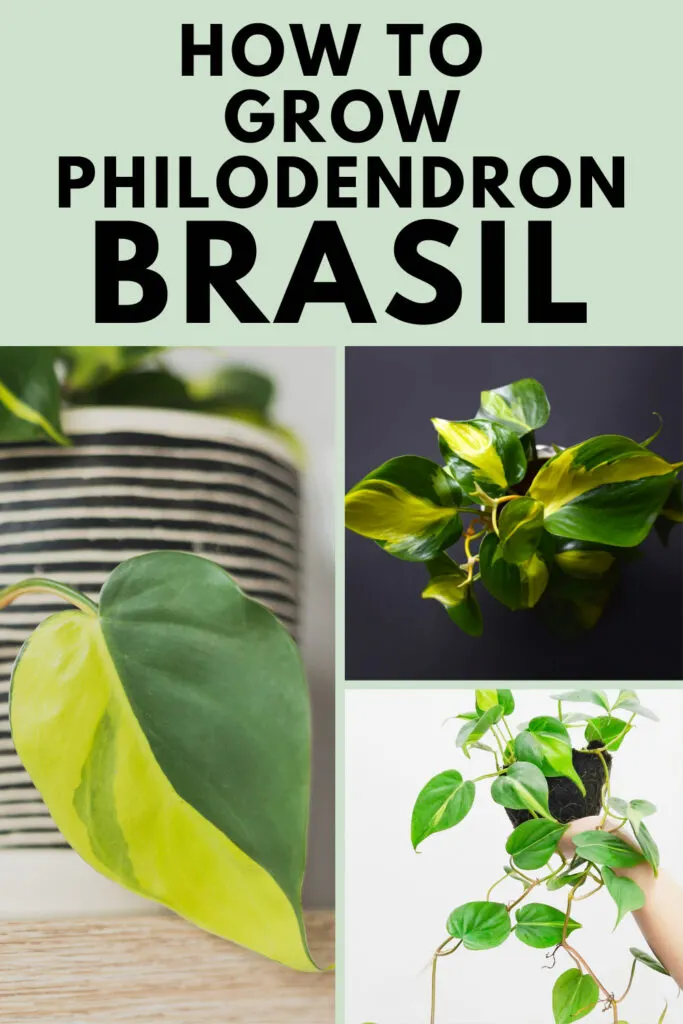
Sometimes you’ll see this plant listed as Philodendron Brazil (with a z) instead of Brasil (with an s). It is the exact same plant and they are completely interchangeable.
Before getting into care information, it is also worth mentioning that the care for this plant is absolutely identical to the plain old Heart Leaf Philodendron that has solid green leaves and seems to be everywhere.
Table of Contents
PHILODENDRON BRAZIL CARE
1. LIGHT
Although many Philodendron varieties are labeled as low light plants, you’ll want to give your Philodendron hederaceum Brasil a little more light since it is variegated.
They can definitely tolerate a wide range of lighting, but will respond better if you give them plenty of natural light, or even supplement with artificial light if you’re lacking good windows in your home.
In many cases, the variegated version of a plant needs more light than the non-variegated version of the same plant.
Otherwise you may lose your variegation, which is probably the reason that you obtained this plant in the first place!
Philodendrons in general like bright indirect light. For best results, a little bit of direct sun probably will help your plant look even better.
Just don’t cook your Philodendron Brasil in full sun all day. They are not meant to take excessive amounts of direct sun.
A bright North window would work, as would East windows where they can get a little bit of morning sun.
I keep mine hanging in a warm room in front of an Eastern facing window and it loves it. The newest leaf is even completely variegated!
This could eventually be a problem though so keep reading the entire post to learn about how to manage your plant’s variegation.
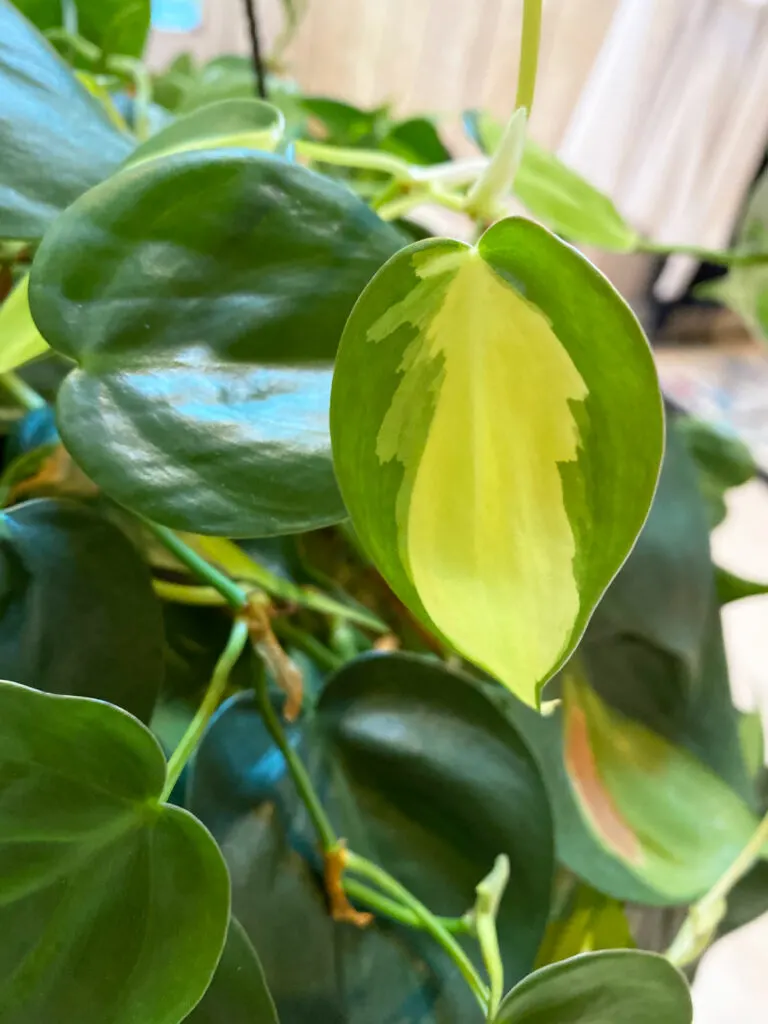
Avoid giving your plant excessive amounts of direct sun. If all you have are very sunny Western or Southern windows (which is a good problem to have!) you may want to either set your plant slightly off to the side or a little further away from the window.
Another option for very sunny windows is to use sheer curtains or blinds to diffuse the sun. Again, depending on where you live, Eastern windows should work well for you (unless you live close to the equator or in areas with strong sun).
Just be observant and see how your plant responds to the conditions that you are providing for it.
2. TEMPERATURE
In general for many houseplants, if you are comfortable, they will be comfortable! Average room temperatures will do just fine.
These plants definitely like warmer temperatures, and an ideal temperature range would be 60-85F (about 16-29C). Avoid nighttime temperatures much below 55F (approximately 13C).
This is a good general, safe rule of thumb for most houseplants. Of course there are always exceptions.
Lastly, avoid any cold drafts.
3. WATERING
As far as watering your Philodendron Brasil, I like to use my “standard” approach for most of my houseplants.
Use your finger to judge the dryness of your soil in order to help you determine when to water your plant. This plant hates extremes in moisture.
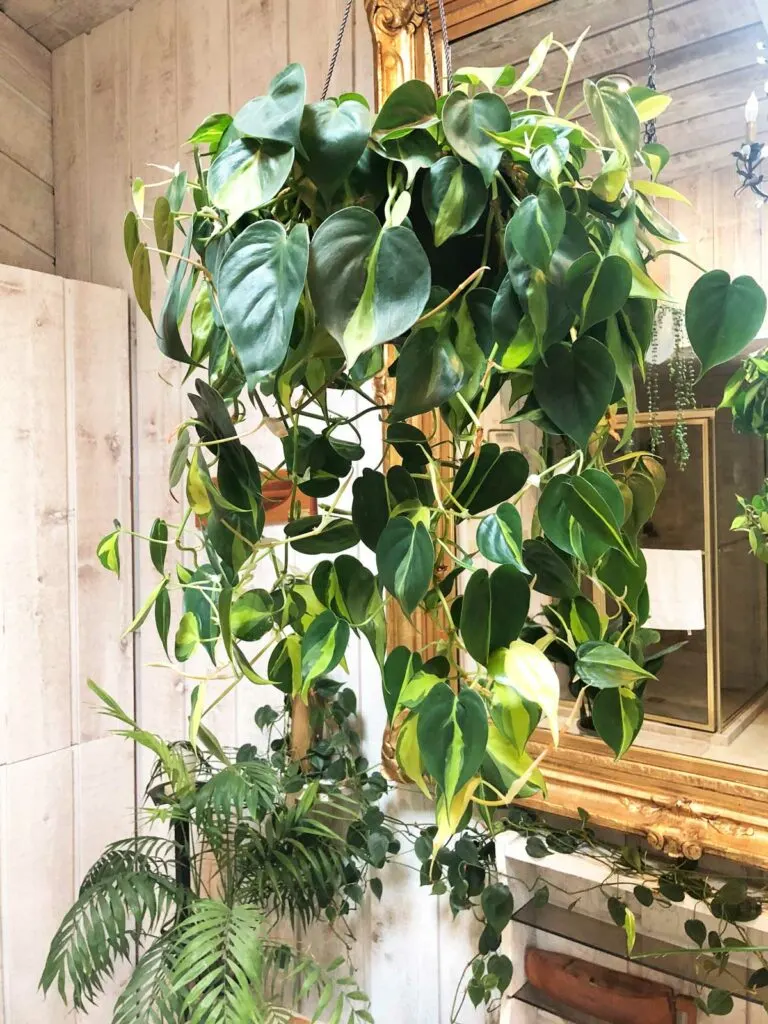
Never, ever let your Philodendron Brasil completely dry out. I know life happens and it’s hard sometimes, but if you can avoid it, it would be best!
If you keep doing this repeatedly, your lower leaves will yellow and turn brown and the plant will get leggy.
On the other end, be sure to provide excellent drainage and never let this plant sit in water otherwise it may rot or stay wet for too long.
A good rule of thumb is to allow the top inch of soil to dry out before thinking about watering again. These plants can really tolerate all sorts of neglect, as long as you avoid extremes in soil moisture (especially for longer periods of time).
If you have your plant in a hanging basket, let me give you a tip for making sure that your hanging baskets are being properly drained.
Check out the bottom of the hanging basket that my plant is growing in below.
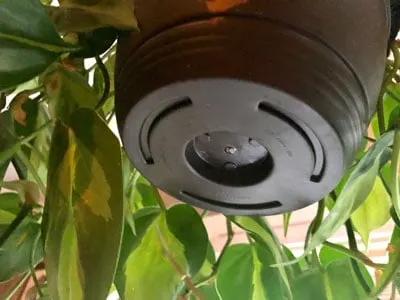
Does the bottom of your hanging basket look like this? Many of the pots that are used for hanging baskets will have reservoirs at the bottom of the pot and it’s pretty deep.
Since my Philodendron Brasil is hanging right over a couch, I like to take it to the sink to water it so I don’t get water all over our couch.
I’ll thoroughly soak the pot and allow all the water to drain out. Make sure you water around the entire pot and not just in one area.
Additionally, I will tip the pot over at a 45 or 60 degree angle or so, so the water that collects at the reservoir completely drains away. You may need to give it a minute or two to make sure all the water has gotten a chance to drain away.
If you don’t do this, your plant may be sitting in water for a while and stay wet for too long! This same procedure would apply if you have any kind of saucer that your plant sits in.
Discard any excess water otherwise soggy soil can encourage root rot.
Whatever type of pot your plant is growing in, make sure that it does have at least one drainage hole.
4. WATERING METERS?
I’ve noticed a trend lately of people using watering meters, or moisture meters. You simply stick the device in the soil and it tells you the moisture level. If that helps you, by all means do it.
But I honestly would not trust those devices (especially the inexpensive ones).
I don’t trust them for multiple reasons. One, they make plant care too black and white and take your powers of observation away. And if you blindly trust the meter, when something goes wrong, you don’t know why.
Secondly, I just don’t trust the readings that it gives you. In fact, I feel so passionately about the topic that I wrote a blog post specifically to call out the dangers of using moisture meters.
My comments apply to the inexpensive moisture meters. There are good ones out there, but they will be quite expensive and I don’t think it’s necessary at all to use these devices.
Stick with just using your senses. Use your finger to feel the surface of the soil. A good rule of thumb for ANY tropical foliage houseplant is to allow the top inch or two of the soil dry out, and then water thoroughly.
In my opinion, this works much better than any “fancy” gadgets and your finger is free! No need to buy any junky equipment that you can’t rely on.
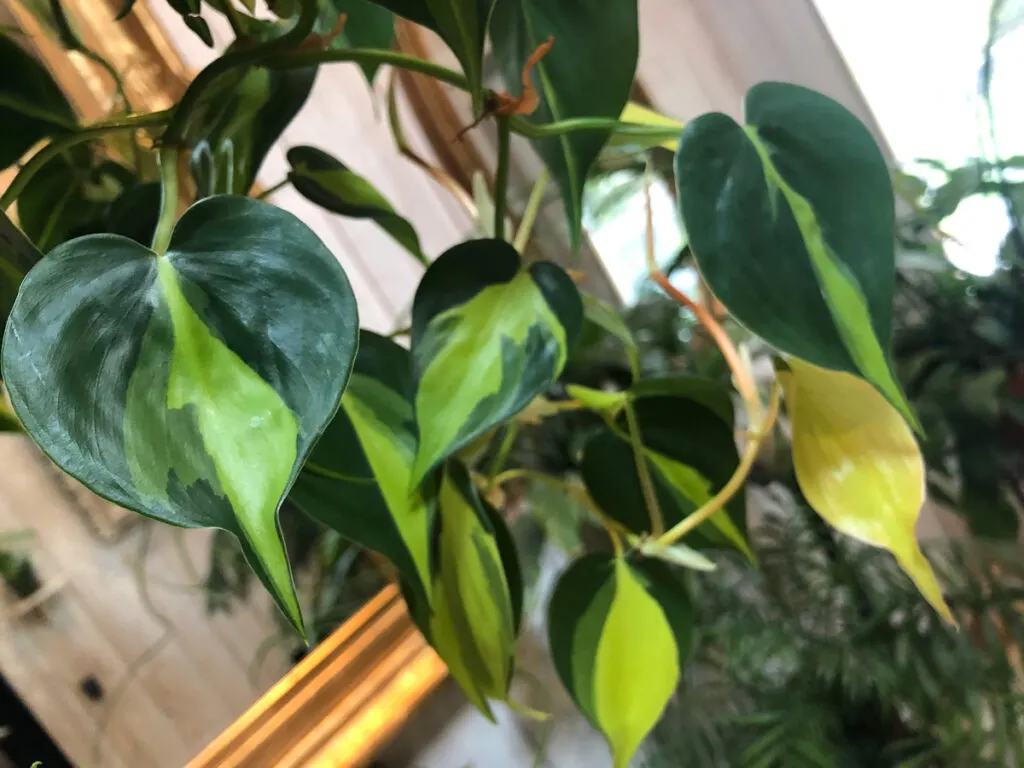
5. FERTILIZING
If you follow me closely, you know how I prefer to fertilize my houseplants. Dilutely and with every watering.
An absolutely fantastic liquid fertilizer that I now use for most of my houseplants is Dyna Gro Grow (available in this link from Amazon).
It is a premium fertilizer which offers a complete formulation for your plants. It contains all the necessary macro and micro nutrients and is urea-free.
I simply add 1/4 teaspoon of the fertilizer to a plastic gallon that I reuse. I After adding the fertilizer, I fill it with tap water, and water my plants with it. Don’t eyeball the amount.
Use a measuring spoon and a gallon jug. You can run into trouble if you eye ball things.
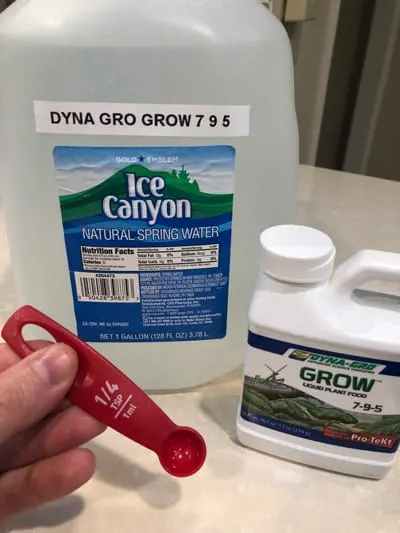
I’m achieving wonderful results with Dyna-Gro Grow. You can use any all-purpose fertilizer out there and get good results, but you will have even better results with this fertilizer.
And if you are not fertilizing, then you should start! Nutrients will be depleted very quickly in our indoor pots. Our soil indoors will not be replenished with organic matter like it is in nature, so we have to do nature’s job and provide fertilizer.
It is an important part of your houseplant care routine.
I fertilize all my houseplants from about late winter through the beginning of Autumn, and then I stop fertilizing during the winter months.
6. HUMIDITY
Philodendrons love high humidity, but many of them are very tolerant of average indoor conditions, so you don’t have to worry too much.
If you do want to learn about how to
7. POTTING SOIL
Any well draining potting mix will do. Potting mixes really are endless and many different mixtures will work for you, as long as they provide good drainage.
I rarely use any potting mixes as-is.
I like to take a good all-purpose potting mix, or whatever you have on hand, and add perlite or even orchid bark chunks to make the blend very well draining for your foliage tropical plants.
For this plant, 3 parts of an all-purpose potting mix plus 1 part of perlite works very well.
If you’re looking for an amazing potting mix that you can use straight out of the bag for your Philodendron ‘Brasil’, check out the Tropical Climber Soil Blend from Oh Happy Plants. This is an amazing mix and you will get 10% off at checkout automatically if you use my link.
8. PROPAGATING PHILODENDRON BRASIL
Propagating this plant is very easy! Simply take cuttings from your vines and place them in water or you can place them directly in soil. I will discuss both methods.
Take a look at the illustration below from my plant.
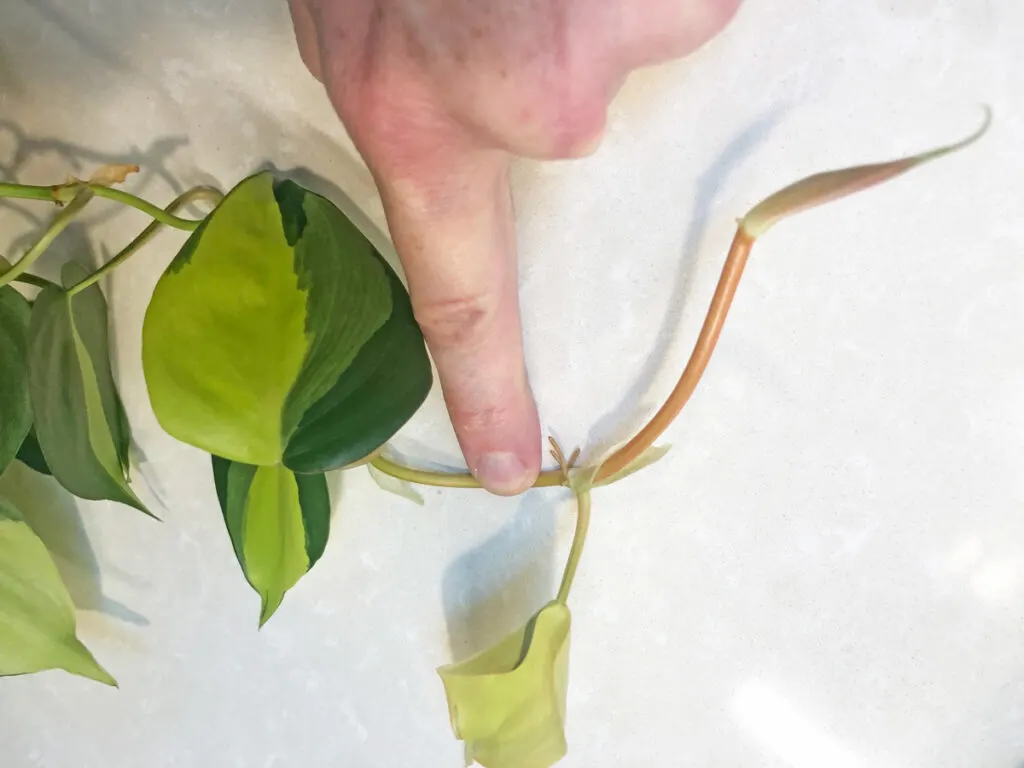
See where my finger is? You can see to the right of my finger a few aerial roots growing out of what is called a node.
The node is where the leaf attaches onto the vine. This is where roots and new vines will grow.
Simply take cuttings long enough so that at least one or two nodes are in water. You’ll also want to make sure that your cuttings still have at least one or two leaves on them.
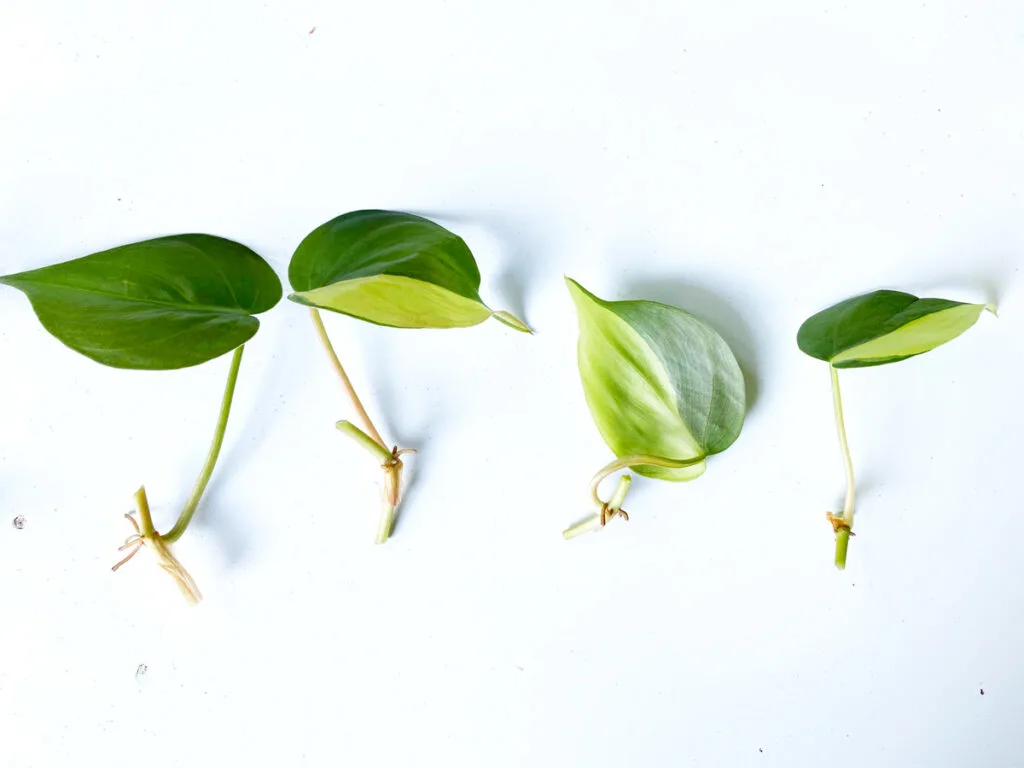
Propagation is best done during the main growing season where you will achieve quicker and better results. Spring and summer months are ideal.
WATER PROPAGATION
Like in the photos above, the nodes already have roots, so these will start growing pretty readily in water. Once they are about an inch long or so, you can transfer them to soil.
And while you’re propagating…don’t miss my guide on the best houseplants to water propagate.
SOIL PROPAGATION
You can also dip the Philodendron cuttings in rooting hormone to speed up the process and plant them directly in soil as well. Rooting hormone is not necessary though!
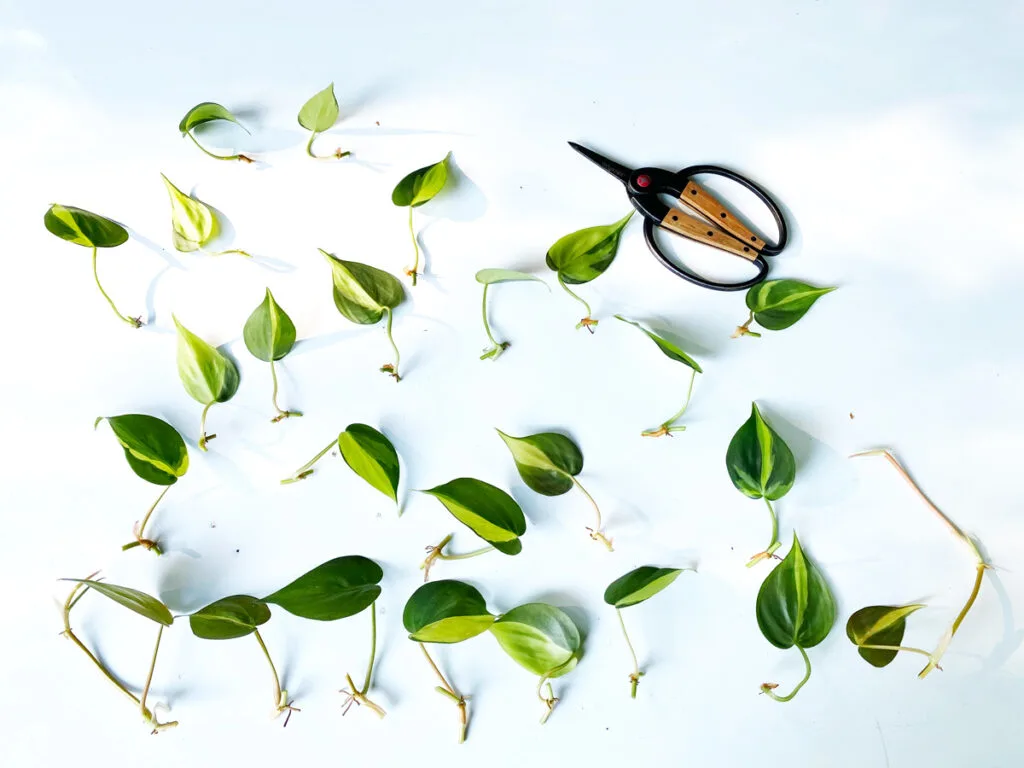
Simply place several cuttings in a pot and bury the node. I like to pre-moisten the potting mix (2-3 parts of potting soil and 1 part perlite), then insert the cuttings, and water the soil again.
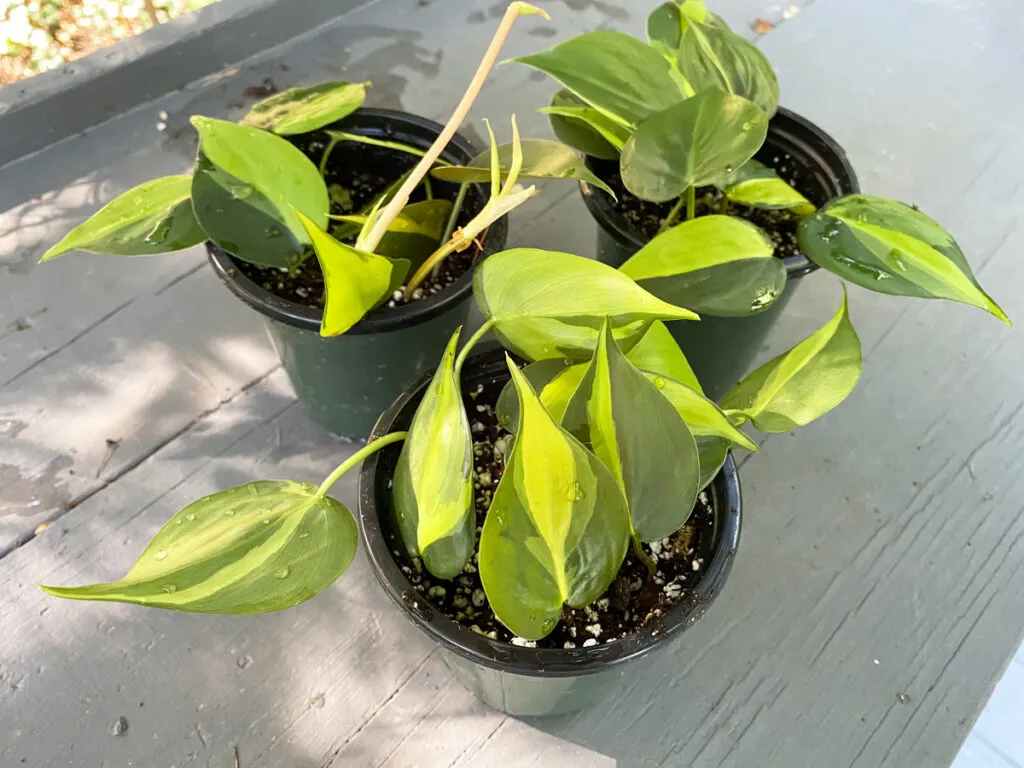
That’s really all there is to it! Keep the soil moist to encourage rooting, and each of the single node cuttings should produce a vine.
In a 4 inch pot, you’ll want about 6-8 cuttings. Don’t just put one or two because otherwise you will never get a full plant. And if you use single node cuttings, you can get a lot more vines that way.
9. OTHER TIPS TO GROWING PHILODENDRON BRASIL
Tip #1: Remove any dry or dead leaves when you notice them. A clean plant is a healthy plant.
Tip #2: You can grow this plant as a hanging plant, or as a climber. Many Philodendrons in nature are climbers! So don’t be afraid to experiment and give your plant a post or something to climb on. Your leaves will eventually get larger if you grow them this way. Check out my blog post on how to make your own moss post.
Tip #3: If your plant has gotten a little sparse and leggy, don’t be afraid to trim the plant back. This will force new growth, and you can then root the cuttings and either make more plants, or plant them back in the original pot to make a fuller plant.
Tip #4: Has your plant started reverting and growing too many all green leaves? Or maybe too many all variegated leaves? You’ll need to trim your plant back to remove all the all green or all variegated leaves otherwise you’ll lose the balance. Simply cut the vine back to the first leaf that exhibits good variegation.
If you don’t trim back the leaves in this case, your plant will either be overrun by too many green leaves and revert back to the all-green variety. Or if there are too many all-variegated leaves, those leaves won’t survive too long and you’ll have to end up trimming it eventually anyway.
You’ll want a balance for a healthy plant. Be sure to read more details on this topic below.
I interviewed the gentlemen that run Steve’s Leaves, a fantastic tropical plant nursery based in Texas, and they taught me how to manage variegated plants.
Read my blog post and scroll down to the “Managing Variegated Plant Growth” Section to see what they have to say! It was a very eye-opening and interesting interview and definitely learned a lot so don’t miss it!
COMMON PHILODENDRON BRASIL PROBLEMS & QUESTIONS
Why are my leaves curling?
The two most common reasons are cold temperatures, or perhaps even more common, dry soil.
If you notice your plant’s leaves curling, immediately feel your potting mix. If it is bone dry, go ahead and give your plant a good soaking.
Why are my leaves wrinkling?
Similar to the previous question, go ahead and feel your potting mix. If your plant has gone dry for too long, the leaves can wrinkle and new growth will be warped and not able to develop properly.
Proper attention to soil moisture is very important. Never allow your plant to dry out completely, but at the same time, you do want at least the surface of your potting mix to dry out before watering again.
Why does my plant have small leaves?
Your plant probably isn’t receiving enough light. Increase your light and move your plant closer to a window.
If you have just recently purchased your plant and your new leaves are smaller, we have to remember that conditions in our home are not as good as where they were grown in greenhouses. This can also result in smaller leaves.
Can I use a moss pole for my Philodendron Brasil?
You certainly can. As your plant climbs up the moss pole and attaches itself, it will gradually get larger leaves as it pushes out new growth. If you want to make your own moss pole, check out my DIY guide to making a moss pole.
Why is my Philodendron Brasil getting yellow leaves?
There are many reasons why plants get yellow leaves, but the most common reason for yellow leaves is improper soil moisture. Either your potting mix has gone completely dry for too long, or it has stayed wet for too long. Feel the soil with your finger to determine which it is, and adjust accordingly. If your soil has gone bone dry for a long time, most often the older leaves will be the ones that yellow first.
How can I tell the difference between Philodendron Brasil vs. Pothos?
I’ve write an entire blog post on this topic where I describe the differences between Philodendron and Pothos and illustrate using photos of my own plants.
I hope you’ve enjoyed this post. Do you grow Philodendron Brasil?

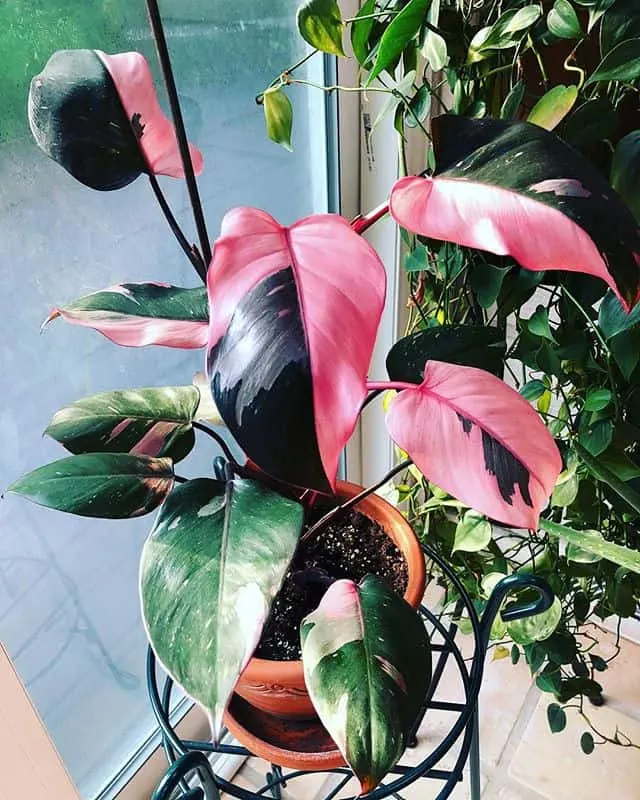
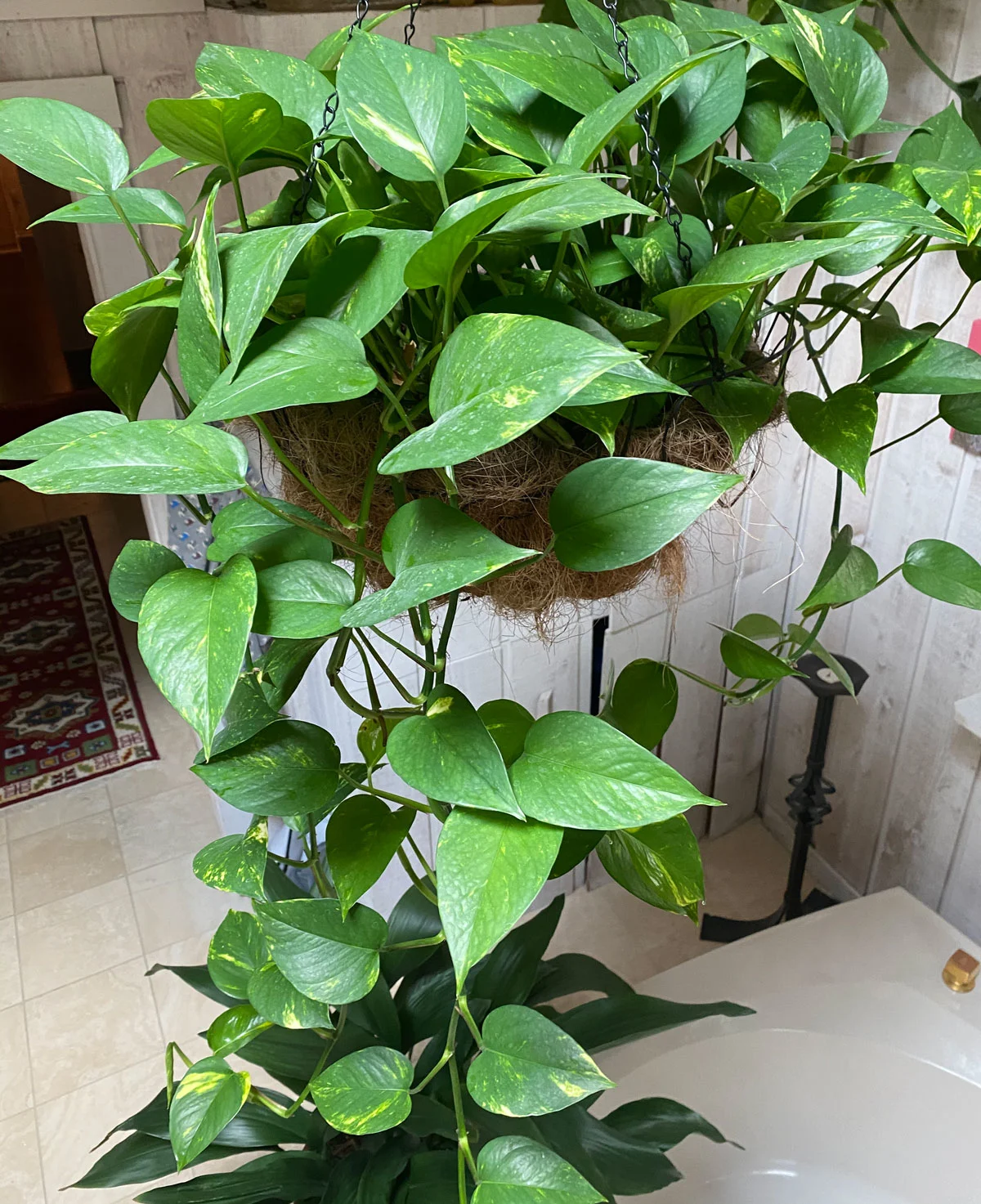
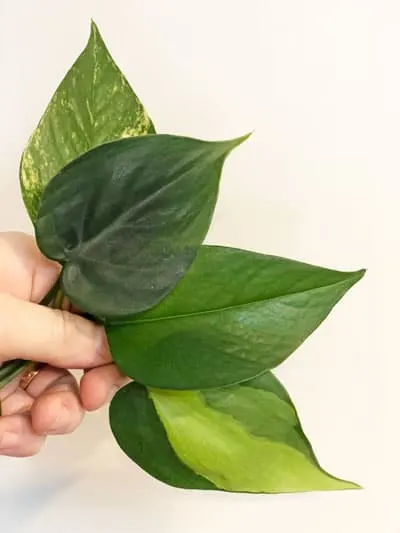
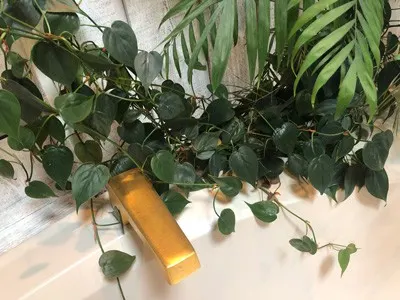
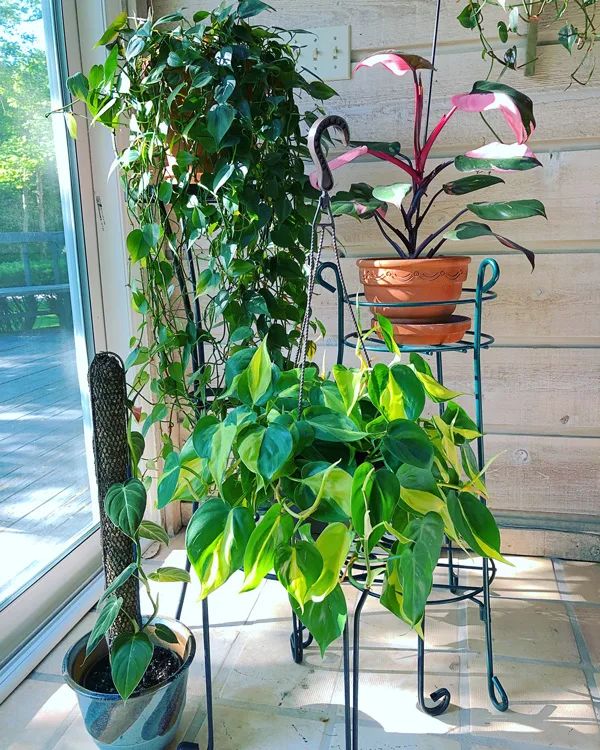
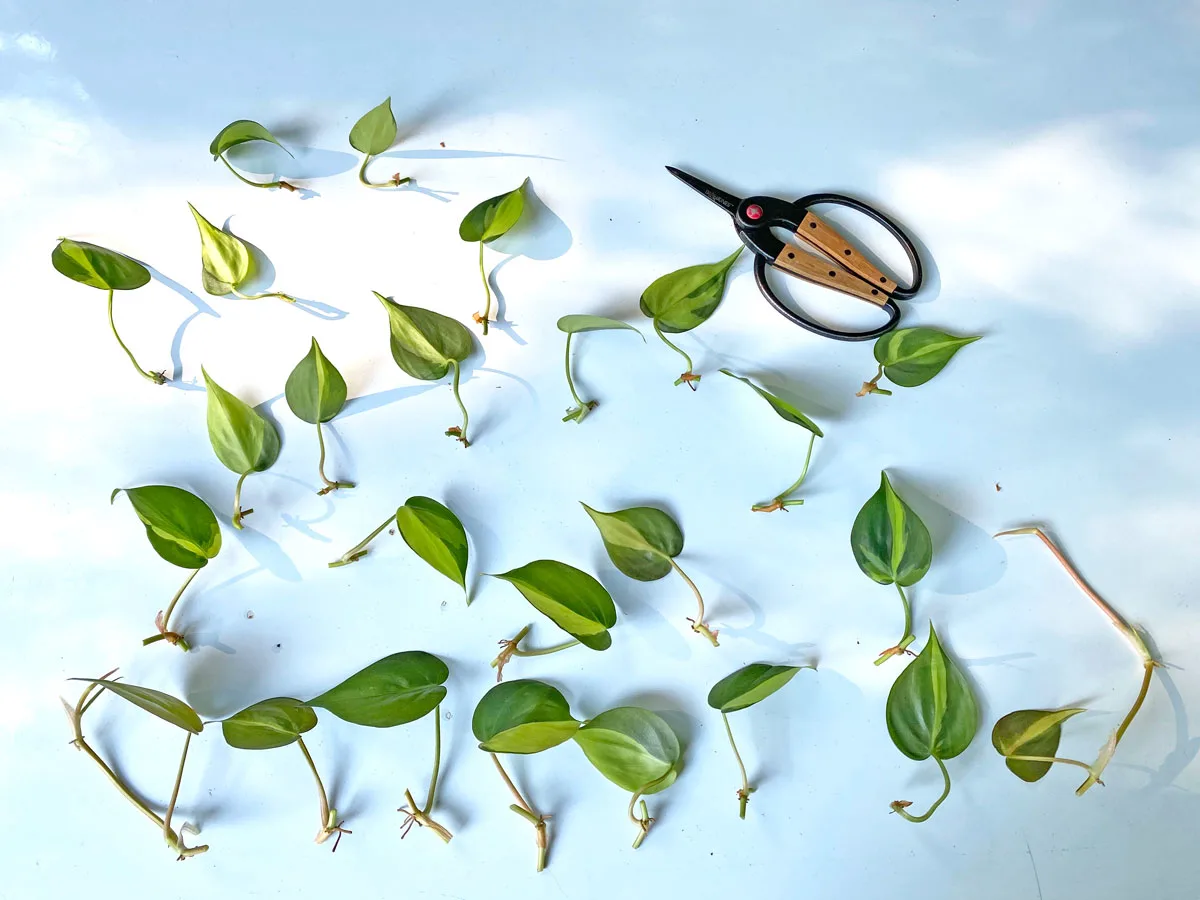
Shazia
Monday 12th of September 2022
This is v informative . I really enjoyed reading the whole post . Thank u for sharing .
Raffaele
Monday 12th of September 2022
Glad you enjoyed it!
Charmaine
Tuesday 2nd of February 2021
How long does it take for new leaves to grow from stems? I have a new philadendron brasil with a few leafless stems (still green) and wondering if those would grow leaves soon
Raffaele
Tuesday 2nd of February 2021
Hi Charmaine! It's difficult to say as it depends on your conditions. I've found that some leafless vines sometimes may never grow leaves. How long are the vines? You may want to prune the leafless vines down to a couple nodes and this may encourage further growth. Hope this helps!
Megan Rayment
Monday 11th of January 2021
My philodendron brasilica is flourishing but is growing as one long vine. If I take a cutting at a new point as descrbed above, where will the new growth come from on the existing plant? I don't want to damage it.
Raffaele
Monday 11th of January 2021
Hi Megan, the new growth will come near the tip where it was cut. It'll come out of a node (where the leaf meets the vine). You're not going to damage it. It will grow back.
Kimya
Tuesday 15th of December 2020
Hello. This is exactly what I needed. I just ordered four new philodendra, which arrived today. One of these is the Brazilian Philodendron, and I was wondering if you recommend I repot it right away. They all arrived in the usual plastic pots from the store. Since I'm just learning plant care (and nearly killed one of my existing philodendron plants when trying to repot, I'm so nervous about having to do this. Any tips you can provide? I live in Southern California. Could I get away with waiting until spring? I would never want to stunt their growth, but I really have no clue what's "best." Thanks in advance for whatever advice you can offer.
Raffaele
Tuesday 15th of December 2020
Hi Kimya! I would allow your plant to adjust to your environment and wait until late Winter or Spring to repot it. When you do, only go up one pot size. For example, if it's in a 4 inch pot, put it in a 6 inch pot. In the meantime, try and follow the light and watering recommendations in my blog post and you will get the hang of its care. Don't rush the process. Too many people want to repot everything right away. Allow an adjustment period for plants and have patience, make observations, and adjust as needed...and all will be well!
Rafiq
Wednesday 25th of November 2020
Hi Raffaele, great article. I learned a lot from it. Thanks. I am now propagating a Philodendron Brasil plant for the first time ever and came accross your article trying to find answers. I am using the water propagation method. My first question is when should I change the water? I have the end of a growing plant with several nodes but 1 mature leaf. Should I remove the other nodes that has no or small leaves or it does not hurt to keep them?
Raffaele
Friday 27th of November 2020
Replace the water about once a week. Are the extra nodes in water? If they are, you can leave them there. If you have several bare nodes in the air, you may want to trim the cutting so it's not just a bare vine with one leaf at the end when you plant it.